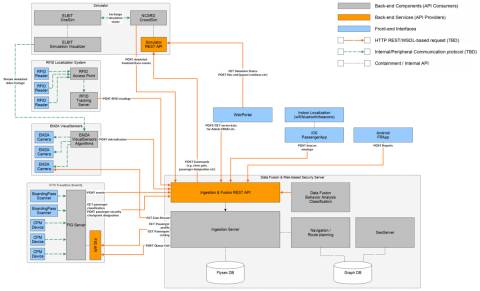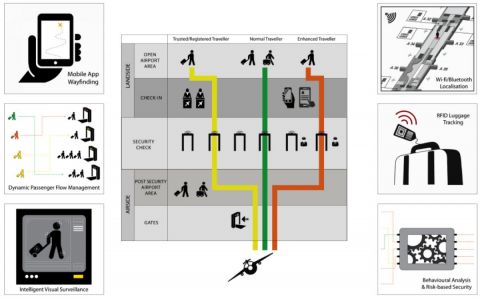About FLYSEC
Τhe FLYSEC project addressed the European Union’s research priority for improving the aviation security chain and aligned with the roadmap and recommendations reflected within the IATA/ACI Smart Security programme. FLYSEC facilitates the three main principles specified in Smart Security: strengthened security, increased operational efficiency and improved passenger experience.
FLYSEC developed and demonstrated an innovative, integrated and end-to-end airport security process for passengers, while enabling a guided and streamlined procedure from landside to airside and into the boarding gates, and offering for the first time an operationally validated innovative concept for end-to-end aviation security.
FLYSEC activities included:
• An innovative process facilitating risk-based screening to achieve a measurable increase of throughput at airports,
• The deployment and integration of new technologies and repurposing existing solutions towards a risk-based security paradigm shift,
• The improvement of passenger facilitation and customer service, bringing Security as a Service into the airport of tomorrow.
Technically, FLYSEC achieved its ambitious goals by integrating new technologies on video surveillance, intelligent remote image processing and biometrics combined with big data analysis, open-source intelligence and crowdsourcing.
Also, existing technologies such as mobile application technologies for improved passenger experience as well as RFID for carry-on luggage tracking and quick unattended luggage handling were repurposed and integrated into the FLYSEC solution.
FLYSEC achieved implementing a seamless risk-based security process combining the aforementioned technologies with behavioural analysis and innovative cognitive algorithms. A key aspect in the design of the FLYSEC risk-based security is applying ethical-by-design patterns, maximizing the efficiency of security controls through passenger differentiation ranging from “casual” to “enhanced”, while remaining ethical and fair in the process. Policy, regulatory and standardization aspects were examined in the context of FLYSEC innovative security concept.
By involving technologies from different Technology Readiness Levels (TRL), including in-project prototype development, as well as adaptation and extension of more mature solutions or re-purposing of commercial products, FLYSEC validated the operational value of the provided solution through pilot test in a real operational environment.
FLYSEC initially performed a Proof of Concept test at Schönhagen Airport of Berlin, followed by a final field test at Luxembourg International Airport. The latter was executed in a real operational environment involving active security personnel. The successful Lux Airport field test marked the first implementation of SMART SECURITY within the EU Programme for Research and Innovation.
FLYSEC Overall Security Concept
FLYSEC provides an innovative concept for airport security based on:
(i) passenger facilitation,
(ii) risk-based security and
(iii) outcome-focused results.
The concept is based on social acceptance, legal compliance and ethics-by design. In the FLYSEC Secure Tunnels scenario the passengers are differentiated to Trusted, Casual and Enhanced. This gives an indication for differentiated screening of passengers as well. The tunnel is implemented as a virtual path from the landside, through the security check and to the airside where technological components offer intelligence and risk-based security correlations through passive tracking and intelligent analysis.
FLYSEC System Architecture
The Overall Strategy of the FLYSEC Work Plan is based on the agile development of FLYSEC components and system centered around the validation and operational testing methodology: from the simulation fast-track test-bed to the operational testing and Proof of Concept, and to the final field test in a real operational environment.

FLYSEC Impact
Evaluation of the FLYSEC system included a large range of engaged stakeholders, including airport higher management and security practitioners, law enforcement agencies, airport commercial/sales, passengers’ departments and others.
The FLYSEC project may be closing at the end of July 2018, however its impact and next actions are to follow in the short, mid and long term.
FLYSEC validated an innovative concept and identified opportunities in process optimization and regulatory framework.
FLYSEC provides promising and enabling technical solutions which will also be further developed for a closer to market technology readiness level, including computer vision analytics, AI and machine learning algorithms as well as on the fly identification and screening techniques.
Finally, the alignment between FLYSEC and the IATA/ACI Smart Security programme paved the path for the promotion of FLYSEC into a certified Smart Security implementation.
As the risk-based screening paradigm shift is further adopted and developed in other border modalities and security applications, the FLYSEC project provides the reference validated implementation within the framework of the EU Horizon
2020 and beyond.
Project Information:
FLYSEC «Optimising time-to-FLY and enhancing airport SECurity»
Grant agreement ID: 653879
Start Date: May 1, 2015
End Date: July 31, 2018
Funded under: H2020-EU.3.7. - Secure societies - Protecting freedom and security of Europe and its citizens
Overall Budget: € 4 141 375
Coordinated by: National Centre for Scientific Research “Demokritos”, Institute of Informatics & Telecommunications, Integrated Systems Laboratory
Partners: EXODUS ANONYMOUS ETAIREIA PLIROFORIKIS, ELBIT SYSTEMS LTD, I.C.T.S. UK LIMITED, EMZA VISUAL SENSE LTD, CG SMARTECH LTD, EASC EV, SOCIETE DE L AEROPORT DE LUXEMBOURG SA, UNIVERSITE DU LUXEMBOURG, EMBRY – RIDDLE AERONAUTICAL DEUTSCHLAND GMBH, EPSILON INTERNASIONAL SA


